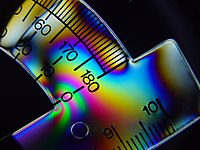
Photo from wikipedia
Reduced models describing the Lagrangian dynamics of the Velocity Gradient Tensor (VGT) in Homogeneous Isotropic Turbulence (HIT) are developed under the Physics-Informed Machine Learning (PIML) framework. We consider VGT at… Click to show full abstract
Reduced models describing the Lagrangian dynamics of the Velocity Gradient Tensor (VGT) in Homogeneous Isotropic Turbulence (HIT) are developed under the Physics-Informed Machine Learning (PIML) framework. We consider VGT at both Kolmogorov scale and coarse-grained scale within the inertial range of HIT. Building reduced models requires resolving the pressure Hessian and sub-filter contributions, which is accomplished by constructing them using the integrity bases and invariants of VGT. The developed models can be expressed using the extended Tensor Basis Neural Network (TBNN) introduced in [1]. Physical constraints, such as Galilean invariance, rotational invariance, and incompressibility condition, are thus embedded in the models explicitly. Our PIML models are trained on the Lagrangian data from a high-Reynolds number Direct Numerical Simulation (DNS). To validate the results, we perform a comprehensive out-of-sample test. We observe that the PIML model provides an improved representation for the magnitude and orientation of the small-scale pressure Hessian contributions. Statistics of the flow, as indicated by the joint PDF of second and third invariants of the VGT, show good agreement with the ”ground-truth” DNS data. A number of other important features describing the structure of HIT are reproduced by the model successfully. We have also identified challenges in modeling inertial range dynamics, which indicates that a richer modeling strategy is required. This helps us identify important directions for future research, in particular towards including inertial range geometry into TBNN. ∗ [email protected] † [email protected] ‡ [email protected] 1 ar X iv :2 10 8. 07 24 4v 1 [ ph ys ic s. fl udy n] 1 6 A ug 2 02 1
Journal Title: Physical Review Fluids
Year Published: 2021
Link to full text (if available)
Share on Social Media: Sign Up to like & get
recommendations!